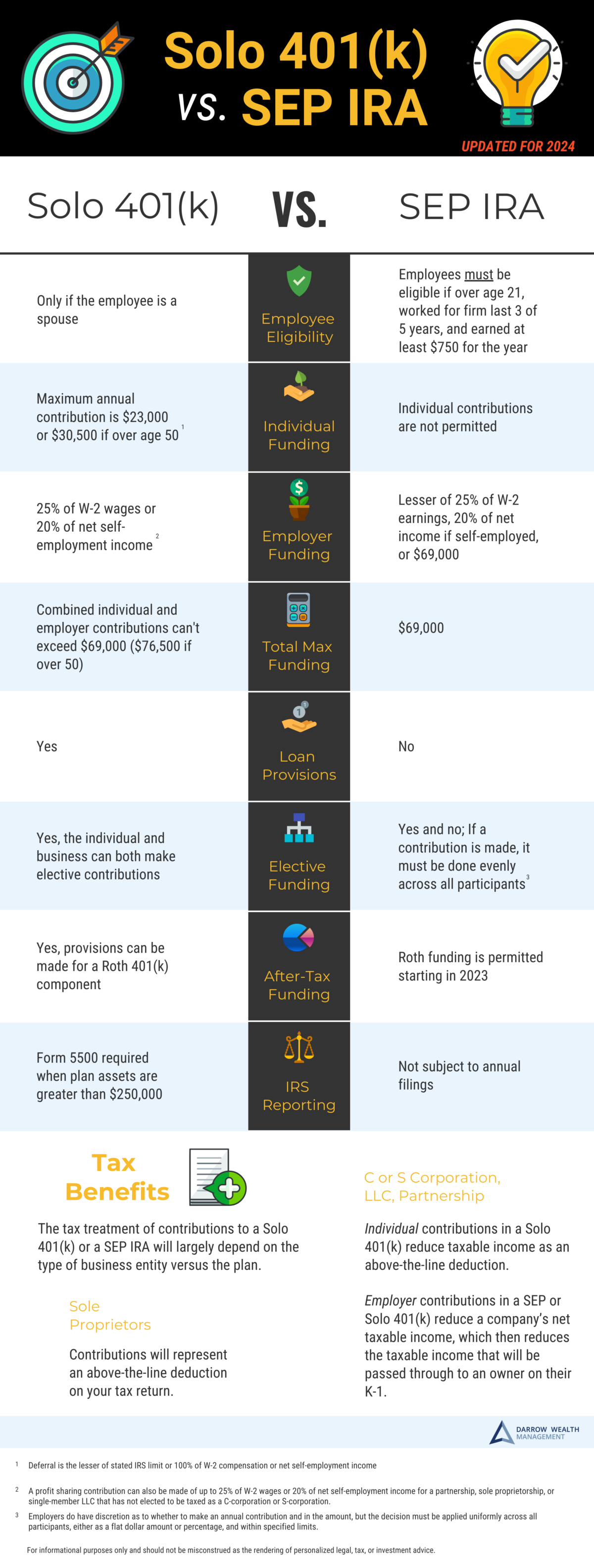Updated for 2024. If you’re looking for a self-employed 401(k) look no further than the Solo 401(k) plan. The Individual (or Solo) 401(k) plan is very similar to a traditional 401(k) plan, only designed for business owners with no employees. Compared to the other types of retirement plans typically used by self-employed individuals, the Solo 401(k) offers a higher contribution limit, tax-deferred growth, a wide array of investment options, plus loan provisions.
There is a lot to juggle as a business owner, but don’t overlook the importance of having a solid investment management strategy and retirement plan. The Individual 401(k) is one of the best self-employed retirement plans for solopreneurs or someone running a business on the side.
The Individual or Solo 401(k) is only suitable for self-employed individuals or the owners of a small business (sole proprietors, partnerships, C and S corporations) with no other employees, unless that employee is a spouse. If you have other employees or expect to hire in the future, this likely is not the best option for you.
Top 4 reasons to use a Solo 401(k):
- Contribution limits are likely higher than a SEP IRA for many business owners
- Easy and affordable to set up and contribute to
- Tax deductions for you and your business
- Flexible for you to start and stop contributions as an individual or from the company
How much can you contribute to a Solo 401(k)? 2024 contribution limits
Contributions for self-employed 401(k)s come in two parts: the elective contribution (at the individual level) and a profit sharing contribution (at the business level):
- The maximum elective deferral in 2024 is the lesser of $23,000 ($30,500 if over age 50 due to the $7,500 catch up contribution) or 100% of W-2 compensation or net self-employment income.
- A profit sharing contribution can also be made of up to 25% of W-2 wages or 20% of net self-employment income for a partnership, sole proprietorship, or single-member LLC that has not elected to be taxed as a C-corporation or S-corporation.
In 2024, the total annual contribution for the company and individual together cannot exceed $69,000 ($76,500 if over age 50).
How to open a self-employed traditional or Roth 401(k) plan
Setting up a traditional or Roth Solo 401(k) can be done with most major financial institutions. Here’s how you can set up your own 401(k):
- Choose a custodian: You can set up a Solo 401(k) at most qualified financial institutions. Make sure the investment options and services meet your needs.
- Complete the paperwork: If you want to contribute on an after-tax Roth basis, you’ll want to make sure to enable that feature in the plan documents. Custodians will often have prototype plans, which essentially means they offer out-of-the-box plan documents that self-employed business owners can use to customize their 401(k). This really helps streamline the process! If you’re working with a financial advisor, they can prepare the paperwork for you, otherwise, contact the financial institution.
- Fund the account: Find out what options the custodian offers to make contributions to your 401(k). If you are paying yourself through payroll, have your personal 401(k) contributions routed in payroll. Make sure to track your contributions – the financial institution won’t do it for you and funding for a calendar year can happen the next year. Discuss contribution limits and maximum funding with your CPA or tax advisor, who can also help calculate the employer contribution.
Self-employed 401(k) tax deductions
The Individual 401(k) offers tax benefits like other qualified retirement plans. For sole proprietors, the employee and employer contribution is combined as an above-the-line tax deduction.
If your business is taxed as a C-corporation, S-corporation, multi-member LLC or partnership, the tax benefits will be split in two parts:
- Your employee contribution will reduce your W-2 taxable income as an above-the-line tax deduction.
- The profit sharing contribution from the business is a deductible business expenses, reducing the company’s net taxable income, which then reduces the taxable income that passes through to an owner on their K-1.
Can I contribute to a Solo 401(k) and a 401(k) at my day job?
Other benefits of opening an Individual 401(k):
- 401(k) loan provisions. Potentially penalty-free loans from your 401(k) subject to certain limits.
- Flexibility. The Solo 401(k) allows optional contributions by both the individual and the business. You can change this amount during the year or decide to skip it if you wish.
- Catch-up contributions. The availability of the catch-up contribution after age 50 may allow business owners to save more compared to other types of qualified retirement plans.
- After-tax Roth component. Similar to other 401(k) plans that have a Roth component, an Individual 401(k) can be designed as either a Traditional Individual 401(k) or a Roth Solo 401(k) plan. There are no income limits for contributions to a Roth Solo 401(k). But keep in mind, annual contributions must stay within the limits.
Possible drawbacks to consider:
- Administration and reporting. Unlike the SEP IRA which is not subject to annual IRS filings, annual reporting is required for Individual 401(k) plans. Filing form 5500 is necessary when the account reaches $250,000 at the end of the year
- No employees allowed. Except for a spouse, Solo 401(k) plans do not allow any other employees of the business
- More restrictive timelines to set up and fund. Compared to the SEP IRA, the Solo 401(k) offers less flexibility for business owners to set up and fund. Plans must be set up by December 31st in most cases. Unincorporated businesses (sole proprietorship, LLCs) must fund their plan by the corporate tax return deadline, including extensions. Individual elective deferrals must be declared by December 31st even though funding can be postponed. Incorporated businesses (C or S corporations) may also wait until the tax filing deadline, including extensions, for the employer contribution. However, employee deferrals must occur within 7 days of electing the contribution. To avoid issues, annual employee contributions should be done before December 31st.
Self-employed retirement plan comparison: Solo 401(k) vs SEP IRA
Retirement planning for business owners with a Solo 401(k)
As a business owner, you are always juggling multiple priorities and likely focused on short-term hurdles. Once a Solo 401(k) plan is set up, it’s easy to keep up with funding. And if you’re working with a financial advisor, they can help you open your own 401(k), manage the investments, and track contributions. Especially for busy entrepreneurs, it’s so important to have a team of financial and tax advisors to stay on top of your personal finances so you can focus on running your business.
[Last reviewed September 2024]











